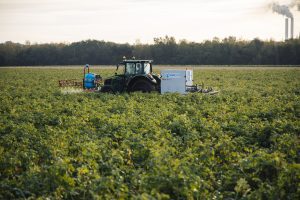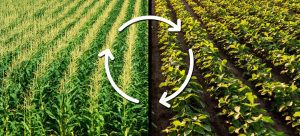Climate change has emerged as one of the most pressing challenges of the 21st century, with far-reaching impacts across various sectors, including agriculture. As the primary source of food and livelihoods for billions of people, agriculture is particularly vulnerable to the changing climate. This article delves into the multifaceted impacts of climate change on global agriculture, highlighting both the challenges and potential adaptation strategies.
Climate change, driven by increased greenhouse gas emissions, is altering weather patterns, increasing the frequency of extreme weather events, and causing shifts in temperature and precipitation. These changes pose significant risks to agricultural productivity, food security, and rural livelihoods worldwide.
- Changes in Temperature and Precipitation Patterns

Increased Temperatures
Rising global temperatures are one of the most direct effects of climate change. Higher temperatures can lead to heat stress on crops and livestock, reducing yields and productivity. Some crops, such as wheat and maize, have optimal temperature ranges for growth. When temperatures exceed these ranges, yields can decline significantly.
Altered Precipitation Patterns
Changes in precipitation patterns, including the frequency and intensity of rainfall, affect water availability for agriculture. In some regions, increased rainfall can lead to flooding, while in others, reduced rainfall can cause droughts. Both extremes pose risks to crop and livestock production, disrupting planting and harvesting schedules and affecting soil moisture levels.
- Increased Frequency of Extreme Weather Events
Droughts
Droughts are becoming more frequent and severe in many parts of the world. Prolonged droughts deplete soil moisture, reduce water availability for irrigation, and stress crops and livestock. This can lead to reduced crop yields, lower livestock productivity, and increased costs for farmers.
Floods and Storms
Floods and storms can cause extensive damage to agricultural land, infrastructure, and crops. Flooding can lead to soil erosion, loss of nutrients, and waterlogging of crops, while storms can physically damage plants and disrupt agricultural activities. The increased frequency of such events poses significant challenges to maintaining consistent agricultural production.
- Shifts in Growing Seasons and Crop Zones
Changing Growing Seasons
Climate change is altering the length and timing of growing seasons. In some regions, warmer temperatures may extend the growing season, potentially allowing for multiple harvests. However, in other regions, the growing season may become shorter due to extreme heat or drought, reducing the time available for crops to mature.
Shifting Crop Zones

As temperatures rise, the geographic ranges suitable for various crops are shifting. Crops that once thrived in certain regions may no longer be viable, while new areas may become suitable for cultivation. This shift requires farmers to adapt by changing crop varieties or even switching to entirely different crops, which can be costly and challenging.
- Impacts on Crop Yields and Quality
Yield Reductions
Climate change is projected to reduce the yields of major staple crops such as wheat, rice, and maize. These reductions are driven by heat stress, water scarcity, and increased prevalence of pests and diseases. Lower yields threaten food security, especially in regions heavily dependent on agriculture for sustenance and income.
Quality Deterioration
In addition to yield reductions, climate change can also affect the quality of agricultural products. Higher temperatures and increased CO2 levels can alter the nutritional content of crops, reducing protein, vitamin, and mineral levels. This has implications for human nutrition and health, particularly in vulnerable populations.
- Impacts on Livestock and Fisheries
Livestock Production
Livestock are susceptible to heat stress, which can reduce feed intake, growth rates, and reproductive performance. Changes in forage quality and availability due to altered precipitation patterns also affect livestock productivity. Additionally, the spread of vector-borne diseases poses a significant threat to livestock health.
Fisheries and Aquaculture
Climate change impacts marine and freshwater ecosystems, affecting fish stocks and aquaculture. Ocean warming, acidification, and changes in salinity can disrupt fish breeding and migration patterns. This poses risks to food security and the livelihoods of communities dependent on fishing and aquaculture.
- Socio-Economic Impacts
Food Security
The combined effects of reduced crop yields, quality deterioration, and disruptions in livestock and fisheries production threaten global food security. Vulnerable populations, particularly in developing countries, are at greater risk of hunger and malnutrition due to their reliance on agriculture and limited capacity to adapt.
Economic Impacts
Agriculture is a significant economic sector in many countries, providing employment and income for millions of people. Climate change-induced disruptions can lead to economic losses, increased costs for adaptation measures, and reduced income for farmers. This can exacerbate poverty and inequality, particularly in rural areas.
- Adaptation Strategies
Sustainable Agricultural Practices
Implementing sustainable agricultural practices is crucial for enhancing resilience to climate change. Techniques such as conservation tillage, crop rotation, and agroforestry can improve soil health, water retention, and biodiversity, reducing vulnerability to climate impacts.
Crop Diversification and Improved Varieties

Diversifying crops and developing climate-resilient varieties through breeding and biotechnology can help farmers adapt to changing conditions. Drought-resistant, heat-tolerant, and pest-resistant crop varieties can improve yields and reduce losses under adverse conditions.
Water Management
Effective water management practices, including rainwater harvesting, efficient irrigation systems, and watershed management, are essential for coping with altered precipitation patterns. These practices can enhance water availability and reduce the risk of drought.
Policy and Institutional Support
Governments and international organizations play a critical role in supporting adaptation efforts. Policies that promote research and development, provide financial assistance, and facilitate knowledge sharing can empower farmers to adopt adaptive practices. Strengthening agricultural extension services and early warning systems can also enhance preparedness and response to climate risks.
- Comparative Analysis of Regional Impacts
Table 1: Comparative Analysis of Regional Impacts of Climate Change on Agriculture
| Region | Key Impacts | Adaptation Strategies |
| Africa | Severe droughts, reduced yields, food insecurity | Drought-resistant crops, water management |
| Asia | Flooding, altered growing seasons, pest outbreaks | Improved irrigation, crop diversification |
| Europe | Heatwaves, water scarcity, shifting crop zones | Sustainable practices, policy support |
| North America | Extreme weather, changing crop zones | Technological innovation, insurance schemes |
| South America | Deforestation, reduced yields | Agroforestry, sustainable land management |
| Oceania | Water scarcity, heat stress | Water-efficient crops, conservation practices |
Analysis Table: Impacts and Adaptation Strategies
| Impact Category | Specific Impact | Adaptation Strategy |
| Temperature Increase | Heat stress on crops and livestock | Development of heat-tolerant crop varieties |
| Altered Precipitation | Droughts and water scarcity | Efficient irrigation systems, rainwater harvesting |
| Extreme Weather Events | Floods, storms, and soil erosion | Improved drainage, flood-resistant crops |
| Growing Season Shifts | Shortened or extended growing periods | Adjusting planting schedules, crop rotation |
| Crop Yields and Quality | Reduced yields and nutritional quality | Crop diversification, biofortification |
| Livestock Production | Reduced productivity and disease spread | Improved shelter, disease management |
| Fisheries and Aquaculture | Disrupted breeding and migration | Sustainable fishing practices, habitat restoration |
| Food Security | Increased risk of hunger and malnutrition | Food assistance programs, resilience-building |
| Economic Impacts | Income loss, increased costs | Financial support, insurance schemes |
In conclusion, the impact of climate change on global agriculture is profound and multifaceted. By understanding these impacts and implementing adaptive strategies, the agricultural sector can better prepare for and mitigate the challenges posed by a changing climate. The collective effort of governments, farmers, researchers, and communities is essential to ensure the sustainability and resilience of agriculture in the face of climate change.
Conclusion
Climate change presents significant challenges to global agriculture, threatening food security, livelihoods, and economic stability. However, with proactive adaptation strategies, sustainable practices, and robust policy support, it is possible to mitigate these impacts and build resilience. The global agricultural community must act collectively to address the multifaceted challenges posed by climate change, ensuring a sustainable and secure food future for all.












